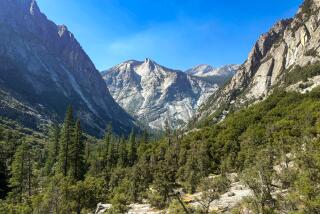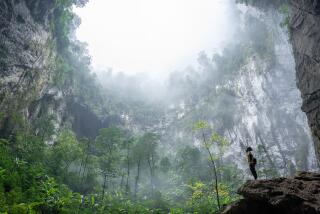Kentucky Park Split Into Three Different Worlds
- Share via
MAMMOTH CAVE, Ky. — We are below ground in one of the three worlds of Mammoth Cave National Park. The other two worlds are above our heads--along the Green River, best seen by river boat, and in the back country, accessible on foot or horse.
Much of this world beneath the hills and hollows of central Kentucky is still a mystery.
It contains the longest-known cave system in the world, 325 miles, with only 12 miles open to the public. However, uncharted passageways are continuously being mapped by volunteer cavers.
The underground realm is the park’s most popular world. Last year more than 463,000 visitors were led by rangers along routes of a quarter-mile to five miles.
Mammoth was first inhabited about 4,000 years ago. People sought shelter, flint, gypsum and other minerals. Left behind were a few artifacts such as implements and clothing, and several naturally mummified bodies, one of which had the misfortune of being crushed to death by a huge rock now known as “Giant’s Coffin.”
Majestic Atmosphere
The cave’s sole natural entrance was dubbed “the gateway to hell” by slaves forced to mine nitrates during the War of 1812.
Although no single chamber is as large as some at New Mexico’s Carlsbad Caverns National Park, the overall atmosphere is still one of majesty.
Rooms and passageways have been given such names as “Grand Central Station,” “Wright’s Rotunda” and “Cleveland Avenue.” Electrification of the cave didn’t begin until the 1920s, and the snowball-like ceiling formations in the “Snowball Dining Room” are gray from lantern soot.
Past the nitrate mine is the “Methodist Church,” where 19th-Century circuit preachers stood high upon “Pulpit Rock” surrounded by lanterns. Their congregants stood below in darkness.
Before the federal government established the park in 1941 it hosted square dances, parties and weddings. The Swedish Nightingale, Jenny Lind, and Shakespearean actor Edwin Booth performed underground.
Tuberculosis Hospital
In what was doomed to become one of the best-known failures in American medical research, Dr. John Croghan established an underground tuberculosis hospital in the cave in 1843. Not surprisingly, the constant 87% humidity and 54-degree temperature had the opposite of the intended effect.
Guided tours of various lengths and on different themes are given all year (except Christmas), including one that follows a wheelchair-accessible route. Reservations are recommended, especially for the summer-only “wild-cave” tour, which is usually booked months in advance.
Less popular than the cave, but also enticing, is the Green River. We cruised on the paddle boat Miss Green River II, which sails everyday April through October.
Beaver, deer and wild turkey live along the shores. In cliffs high above the river, we could see entrances to other caves.
We cruised past the spot where the underground Echo River, which runs along the deepest level of the cave, empties into the Green River.
Aid for Farmers
The river once played a crucial role for Kentucky farmers who needed to get their crops--generally corn, tobacco and oak--to markets.
Often, farmers built boats of wood from these forests and traveled to New Orleans. Because it was difficult to bring the boats back north, they were broken up and the wood used for houses in New Orleans.
No longer a commercial thoroughfare, the river is devoted to recreation. No fishing license is required. However, 50-pound muskie and 100-pound catfish reportedly have been hauled from its waters.
The third world of Mammoth Cave National Park is not as accessible as the other two. If you want to avoid crowds, head for the back country.
We hiked and camped for three days without seeing anyone, although we found indisputable evidence of horses.
The best way to reach the back country for a day hike or a multiday trek is to drive through the park, cross the river on either of two small diesel ferries, then drive along a gravel road to the beginnings of a trail.
Tiny Green Snakes
A network of meandering trails leads along high ridges and through steep valleys. These trails are filled with little surprises.
A brown toad hops along, a delicate mushroom grows in the leaf mold and an iridescent blue five-lined skunk scurries off a log and out of view. There are box turtles, tiny green snakes and striped zebra butterflies.
Rocks resemble weathered castles and other buildings. One exposed outcropping looked like a human face, another like a giant table. Nature has created what looks like miniature caves drilled horizontally into the sandstone.
You’ll need iodine tablets or a water purification device for drinking stream and river water. Ticks are prevalent and insect repellent is important.
-- -- --
Mammoth Cave National Park is 95 miles south of Louisville near Interstate 65. Contact Mammoth Cave National Park, Box 7, Mammoth Cave, Ky. 42259, (502) 758-2251.
Cave tours cost $2 to $5.50 for adults, $1 to $2.75 for children and senior citizens. Boat trips are $3 for adults and $1.50 for children.
Sites at the main campground are $6 a night, with no reservations accepted. The campground includes modern restrooms but no sewer, water or electrical hook-ups. Pay showers are available.
The summer room rate at Mammoth Cave Hotel is $43.50 double, $34.50 off-season. Cottages cost $24.50 and $31.50 double a night. Reservations are recommended, especially during summer. You can have a large, reasonably priced breakfast at the hotel. Write to Mammoth Cave Hotel, Mammoth Cave, Ky. 42259, or call (502) 758-2225.
For information on hotels, restaurants and activities outside the park, contact the Cave City Tourist & Convention Commission, Box 518, Cave City, Ky. 42127, (502) 773-3131.
For boat reservations on the Miss Green River, call (502) 758-2243.
More to Read
Sign up for The Wild
We’ll help you find the best places to hike, bike and run, as well as the perfect silent spots for meditation and yoga.
You may occasionally receive promotional content from the Los Angeles Times.






